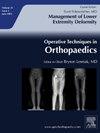Complete Brachial Plexus Injuries: Review of Surgical Techniques and Functional Outcomes
IF 0.3
Q4 ORTHOPEDICS
引用次数: 0
Abstract
Complete brachial plexus injuries (BPI) are among the most severe and debilitating nerve injuries, often leading to extensive motor and sensory loss in the upper extremity. This paper reviews the surgical management of complete BPI, focusing on nerve transfers, functional muscle transfers, and pain management techniques, such as dorsal root entry zone (DREZ) lesioning. Common nerve transfer options in complete BPI include the spinal accessory nerve SAN to the suprascapular nerve (SSN) transfer for shoulder reanimation, (SAN) to musculocutaneous nerve (MCN), intercostal nerves to MCN, phrenic to MCN for reconstruction of elbow flexion, and contralateral C7 transfer for reanimation of finger and elbow flexion. Functional free muscle transfers, most often utilizing the gracilis, are particularly effective in chronic BPI where nerve grafting or nerve transfers are not possible. DREZ lesioning provides pain relief in chronic neuropathic cases. Early intervention and structured rehabilitation are crucial for optimal outcomes. Effective management of complete BPI requires a multidisciplinary approach. Techniques like nerve grafting, muscle transfer, and DREZ lesioning offer significant potential for recovery, while timing and rehabilitation are crucial to improving outcomes. Continued advancements in surgical methods are promising for improving patient recovery and quality of life.
完全性臂丛神经损伤:手术技术和功能结果综述
完全性臂丛神经损伤(BPI)是最严重和使人衰弱的神经损伤之一,通常导致上肢广泛的运动和感觉丧失。本文综述了完全性BPI的手术治疗,重点是神经转移、功能性肌肉转移和疼痛管理技术,如背根进入区(DREZ)损伤。完全性BPI常见的神经转移方法包括脊髓副神经SAN到肩胛上神经(SSN)的转移以实现肩关节复位,(SAN)到肌皮神经(MCN)的转移,肋间神经到MCN的转移,膈神经到MCN的转移以实现肘关节屈曲的重建,以及对侧C7的转移以实现手指和肘关节屈曲的复位。功能自由肌肉移植,最常用的是利用股薄肌,在无法进行神经移植或神经移植的慢性BPI中特别有效。DREZ病变提供疼痛缓解慢性神经病病例。早期干预和有组织的康复是获得最佳结果的关键。有效地管理完整的BPI需要多学科的方法。神经移植、肌肉移植和DREZ损伤等技术提供了巨大的恢复潜力,而时机和康复是改善结果的关键。手术方法的不断进步有望改善患者的康复和生活质量。
本文章由计算机程序翻译,如有差异,请以英文原文为准。
求助全文
约1分钟内获得全文
求助全文
来源期刊

Operative Techniques in Orthopaedics
ORTHOPEDICS-
CiteScore
0.40
自引率
0.00%
发文量
40
审稿时长
83 days
期刊介绍:
Operative Techniques in Orthopaedics is an innovative, richly illustrated resource that keeps practitioners informed of significant advances in all areas of surgical management. Each issue of this atlas-style journal explores a single topic, often offering alternate approaches to the same procedure. Its current, definitive information keeps readers in the forefront of their specialty.
 求助内容:
求助内容: 应助结果提醒方式:
应助结果提醒方式:


